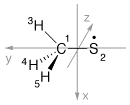ORCA Input Files
The following ORCA input file combines two single point calculations on the methylthiyl radical (CS symmetry) at the UB3LYP/6-31G(d) level of theory in one job:
| ## # UB3LYP/6-31G(d) single point for the CH3S radical # geometry from optimization at UB3LYP/6-31G(d) level with Gaussian (A' state) # use d-exponents from 6-311G(d,p) basis set on C and S # ! UKS B3LYP/G NoRI VeryTightSCF Grid5 UseSym %basis basis "6-31G" NewGTO 6 "6-31G" D 1 1 0.626 1.0 end NewGTO 16 "6-31G" D 1 1 0.65 1.0 end end %output PrintLevel Normal Print[ P_Basis ] 2 Print[ P_MOs ] 1 Print[ P_Density ] 1 Print[ P_SpinDensity ] 1 end * xyz 0 2 C 0.004228 1.115137 0.000000 S 0.004228 -0.697639 0.000000 H -1.047604 1.433182 0.000000 H 0.477299 1.519107 0.899333 H 0.477299 1.519107 -0.899333 * $new_job ## # UB3LYP/6-31G(d) single point for the CH3S radical # using identical geometry and method as before; now calc. A'' state energy # ! UKS B3LYP/G NoRI VeryTightSCF Grid5 UseSym %basis basis "6-31G(d)" NewGTO 6 "6-31G" D 1 1 0.626 1.0 end NewGTO 16 "6-31G" D 1 1 0.65 1.0 end end %scf rotate {11, 12, 90, 1, 1} end end %output PrintLevel Normal Print[ P_Basis ] 2 Print[ P_GuessOrb ] 1 Print[ P_MOs ] 1 Print[ P_Density ] 1 Print[ P_SpinDensity ] 1 end * xyz 0 2 C 0.004228 1.115137 0.000000 S 0.004228 -0.697639 0.000000 H -1.047604 1.433182 0.000000 H 0.477299 1.519107 0.899333 H 0.477299 1.519107 -0.899333 * |
 |
In the first job step a UB3LYP/6-31G(d) single point calculation is done starting from the default model potential guess:
! UKS B3LYP/G NoRI VeryTightSCF Grid5 UseSym
The "UKS" keyword calls for an unrestricted Kohn-Sham (DFT) calculation, the particular functional used being the B3LYP functional in the version also used in the Gaussian program (B3LYP/G). The "NoRI" keyword is included to state that none of the "Resolution of Identity" methods are to be used to accelerate the calculations. The keywords "VeryTightSCF" and "Grid5" control SCF convergence and numerical integration grid density, and are chosen here in a way to give good numerical accuracy. The "UseSym" keyword provides us with the benefit that molecular orbitals are labeled as being symmetric (A') or anti-symmetric (A'') with respect to the principal mirror plane of the CS point group.
The following block of input:
%basis basis "6-31G" NewGTO 6 "6-31G" D 1 1 0.626 1.0 end NewGTO 16 "6-31G" D 1 1 0.65 1.0 end end
defines the basis set to be Pople's 6-31G(d) basis, but uses orbital exponents optimized for the 6-311G(d,p) basis set on carbon (0.626) and sulfur (0.65). The next block of input:
%output PrintLevel Normal Print[ P_Basis ] 2 Print[ P_MOs ] 1 Print[ P_Density ] 1 Print[ P_SpinDensity ] 1 end
defines in some detail the amount of information printed to the output file. Printing the actual basis set used is achieved with (P_Basis), while all other print options (P_MOs, P_Density, P_SpinDensity) describe the results obtained after SCF convergence. The structure of the system is defined next by cartesian coordinates (xyz) taken from a UB3LYP/6-31G(d) geometry optimization of the A' state in the CS point group with Gaussian:
* xyz 0 2 C 0.004228 1.115137 0.000000 S 0.004228 -0.697639 0.000000 H -1.047604 1.433182 0.000000 H 0.477299 1.519107 0.899333 H 0.477299 1.519107 -0.899333 *
A trailing empty line ends the input for the first job step. The keyword:
$new_job
instructs ORCA to read additional input for the next job step. The second part included here differs from the first in an additional printing option for the initial guess and by the additional %scf input block:
%scf
rotate {11, 12, 90, 1, 1} end
end
This latter command interchanges orbitals 11 and 12 (through rotation by 90 degrees), both orbitals being of the spin down type. Remembering that ORCA counts orbitals starting from 0 and also that our system contains 13 spin up (alpha) and 12 spin down (beta) electrons, this command interchanges the highest occupied beta orbital with the lowest unoccupied beta orbital. These two orbitals have different spatial orientation and this spin flip thus interconverts the A' and the A'' state.